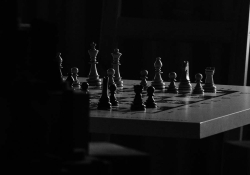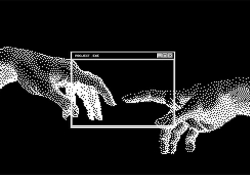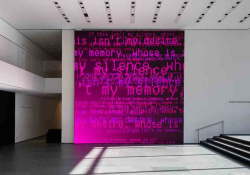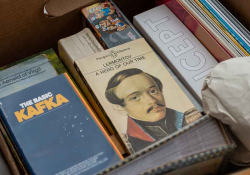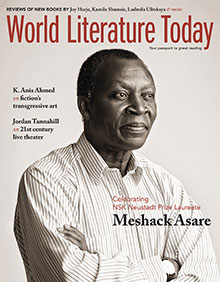Why Live? A Question for 21st Century Theatre
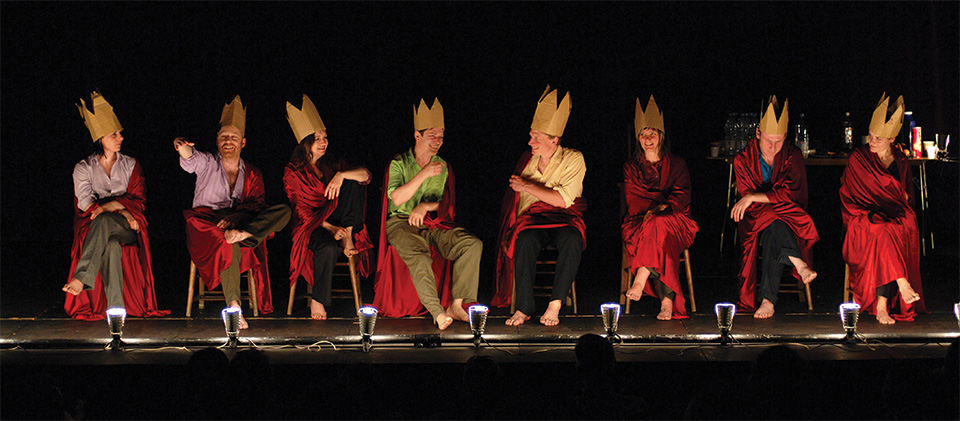
In an era where the screen reigns supreme, why “live”? And in a moment when our lives are becoming increasingly virtual, why bother telling stories the old-fashioned way, with a bunch of bodies gathered in a room?
Eight performers wearing cheap red cloaks and yellow cardboard crowns sit in a row of eight wooden chairs along the edge of the stage. Plainly visible below their cloaks are the performers’ everyday street clothes. Footlights illuminate their faces, recalling both vaudeville and the flashlight held below one’s chin while telling a ghost story. In the upstage darkness there is a table with a pitcher of water, bottles of beer, and snacks—the kind of table one might set out at a party.
A king begins to tell a story. He recounts it as one might to a friend over a pint, casually and without affect: “Once upon a time, a lonely night watchman noticed a pixelated spot in the footage from a security camera installed in a corridor. The footage was otherwise clear except for this one little spot of pixelation. Intrigued by this anomaly, the night watchman went to investigate, only to discover that the pixelation existed in the fabric of reality itself . . .”
“Stop,” says one of the queens, who revises the story: “Once upon a time, a lonely night watchman watched the footage from a security camera installed in a corridor and saw his mother . . .” She continues telling the story until another queen stops her and begins telling a story about a sex-crazed plumber. Then, another king stops her and returns to the story of the night watchman, until he too is interrupted, this time by a king telling a story about a talking dog. Over the course of the night, during these stories, a sprawling cast of characters multiplies, as do subplots involving gay soldiers, wizards in forests, murderous children, and philosophical robots.
As in life, we are perpetually in the process of experiencing the narrative, grasping but never truly able to apprehend its conclusion.
Each story—or is it simply one long, endlessly mutating story?—is dragged up from the memories and imaginations of the eight performers on the spot. Over the course of the six hours we are gathered together, this prismatic narrative seems to contain every story ever told, though no story is ever completed. As in life, we are perpetually in the process of experiencing the narrative, grasping but never truly able to apprehend its conclusion. Moving from the extraordinary to the banal, we encounter stories of religious ecstasy, fables, ghost tales, love stories, domestic tragedies, and a few raunchy sexcapades.
It is clearly a game, and the audience becomes giddy watching the kings and queens play it, competing with one another to hold our attention, interrupting one another and commandeering the narrative, exaggerating certain details or removing key points altogether. The storytelling is at times weary, at other times hysterical, obscene, absurd, tender. At times, some of the kings and queens leave their chairs and wander over to the snack table and take a swig of beer, or lie down for a rest in the darkness beyond the chairs while the others carry on.
At one point in the night, perhaps around ten or eleven, there are only two kings left speaking, and then, twenty minutes later, two queens return, a king leaves, and a half-hour later, without my even noticing it, all eight are back in their chairs. This ebbing and flowing of performers mirrors the ebbing and flowing of the audience in the theatre; we are given permission to come and go as needed, to take a break, grab a bite, empty our bladders. The show is six hours long after all. And there is no pretense of what “should” happen in the theatre. I feel total permission to laugh out loud, to groan, to rest my eyes when I am bored. It feels as if the audience and the performers are truly in this together.
The show is And on the Thousandth Night . . . by the seminal Sheffield, UK–based performance company Forced Entertainment. I caught it during its 2010 run at the Hebbel am Ufer performance center in Berlin. The company describes its work as exploring what theatre can mean in contemporary life and that this exploration is “always a kind of conversation or negotiation, something that needs to be live.”
Something that needs to be live . This feels like the most crucial component to my experience of And on the Thousandth Night . . . This was a piece that could not exist in any other context but as a live performance for an assembled group of people. It was an event, a one-time experience that could never be re-created in quite the same way again, and one that could not exist without our collective presence feeding into it. It was an event insofar as there was a palpable sense of excitement for the performers and audience alike in simply being there and being together, doing this slightly impossible, insane thing with a group of strangers.
•
In an era where the screen reigns supreme, why live?
The dual reading of this question is intentional. What keeps us alive? And in a moment when our lives are becoming increasingly virtual, why bother telling stories the old-fashioned way, with a bunch of bodies gathered in a room? I think both interpretations of this question have a shared answer.
Theatre artists of any age and experience set out to make plays because they’re attempting to access what theatre does best: a live engagement that forces us to confront the humanity of others. It’s likely that at some point in their lives these artists experienced a transformative work of theatre and decided to dedicate themselves to creating similar experiences for others. A play, even a boring one, is rooted in an empathic desire to commune with others, which is more than you can say about mowing a lawn, waxing your car, trading stocks, or any of the millions of other ways that we spend our brief moments on Earth. Plays sit outside our daily routines. They require more of us. And, in their best moments, they can provide us with even more in return.
In his essay “Why Theatre?”, Canadian theatre director Brendan Healy reflects on theatre’s ability to cultivate empathy: “One of the most powerful pieces of theatre that I have seen was a show entitled Rwanda 94, created by a group of survivors from the Rwandan genocide. Over six hours, these survivors, witnesses, musicians, and actors told the horrific story of that nation’s encounter with mass murder. The physical presence of these people who had faced unspeakable darkness prevented me from dissociating myself from the experience; I could not hide behind the protective veil of television or film. I left the theatre transformed. This show truly taught me that the proximity, ‘liveness,’ and immediacy of the theatre allow us to directly experience the world of another person and to learn—intellectually and emotionally—about others. The theatre taps and develops our capacity for empathy.”
Australian playwright Allison Croggan proposes that theatre, with its emphasis on the here and now, is a profoundly local and humanizing force in our increasingly depersonalized global economy: “In an era of globalization the intensely local and unique context of a theatre performance should be something treasured.” Unlike mass media, plays are performed for a specific community, for an audience who must be physically present in order to participate. Often, they are performed for the community in which the actors belong, an audience comprising one’s peers, neighbors, acquaintances, fellow citizens. Healy amplifies this further: “From the rehearsal process to the experience of live performance, the theatre presents the world with a working model of cooperation, collectivity, and community. This makes the theatre essential to a world where the pursuit of individual wealth and consumerism is leading us to economic, environmental, and cultural collapse. The theatre provides citizens with a space to experience the joy of togetherness.”
Of course, people also make and attend theatre simply to have a good time, to be transported and invigorated. In my first year of high school in 2003, I saw a production of Peter Froehlich’s play Simpl, about Weimar Republic beer-hall comedians Karl Valentin and Liesl Karlstadt, at the National Arts Centre in Ottawa. I vividly remember a scene in which the Nazis killed the power to the beer hall. The lights in the theatre abruptly cut out, and five minutes of the play were performed in total darkness. There was a palpable sense of excitement in the adolescent matinee audience; to be plunged into pitch-black with a hundred other people while the play continued all around you (and most remarkably, within your head). I remember thinking at the time: I didn’t know you could do this. In a theatre, a cinema, or anywhere. It was a simple and electric moment that felt unlike any other I’d ever experienced.
Ironically, we have cinema to thank for providing us with the notion of liveness. In his book Liveness: Performance in a Mediatized Culture, Philip Auslander suggests the very concept of liveness only came into existence once recording technology was invented. We could only truly comprehend the characteristics and value of a live engagement once its mediated equivalents were created. Something live occurs only once; like that which is living, that which is live is temporal. But this ephemeral and dynamic aspect of liveness is something that theatre still struggles to reconcile within the age of mechanical reproduction. We continue to rehearse and perform shows with the aim of reproducing the same event—the same text, the same ebbs and flows of laughter and pathos, the same moments of revelation—night after night. In other words, we often aim to create an inert, knowable, and replicable entity.
Montreal-based performance creator Jacob Wren suggests theatre still largely operates in a precinema production model: “To do something many times was the only way. Now, to do something many times, you can have a film. It opens up the space for theatre to be something different.” Wren maintains that there are many theatre artists who realize this, but that there is a general resistance within the community to fundamentally reevaluate the model. “Those artists who realize this will do a few things and the rest of theatre gets scared because it means rethinking everything in a way. It’s the same reason revolution doesn’t happen.”
Lumi Tan, associate curator of The Kitchen, the seminal New York City performance space, argues that theatre needs to embrace the power of its liveness and the uniquely communal aspect of its audience engagement: “Plays need to offer a reason to be experienced live, to accept the flaws that liveness brings, and to leave room for ambiguity as to what and how I am seeing or perceiving. I hate walking away from a play and wondering why it wasn’t a video, why my body needed to share space with others in order to understand it, why it needs to be experienced in ‘real time.’ . . . Even when I’m acting as ‘just’ an audience member and not as a curator, I hope to feel responsible for being there as much as the performers, and I want to be surrounded by others who feel the same way.”
Liveness can exist just as readily in Shakespearean comedy or Chekhovian naturalism as it can in a textless, postdramatic performance piece. Ultimately, liveness is an embodied awareness of time, space, audience, and the potentiality of any given moment.
At one extreme, this means productions that just can’t, or won’t, be the same night after night, like Forced Entertainment’s And on the Thousandth Night . . . But a piece doesn’t have to offer quite such radical instances of audience engagement to possess a sense of liveness. Liveness can exist just as readily in Shakespearean comedy or Chekhovian naturalism as it can in a textless, postdramatic performance piece. Ultimately, liveness is an embodied awareness of time, space, audience, and the potentiality of any given moment.
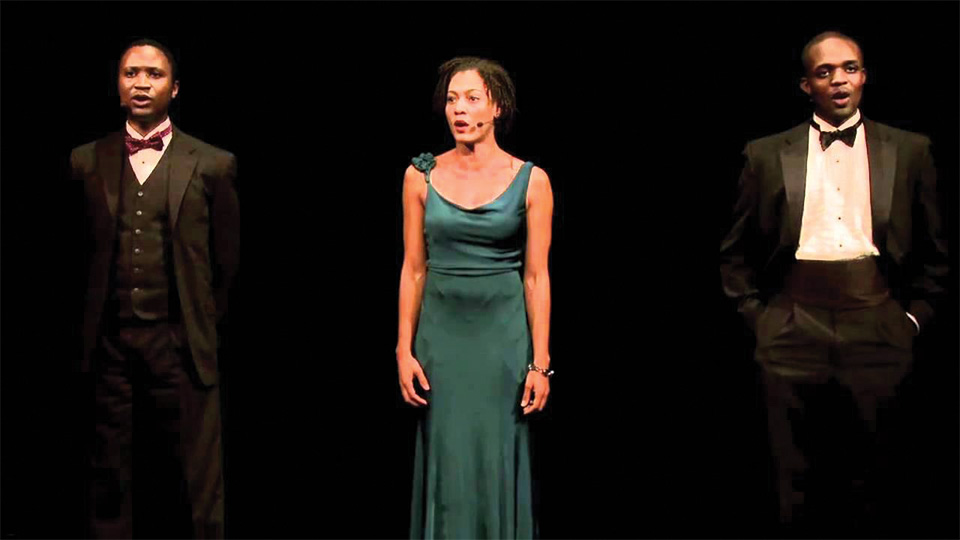
There’s an unforgettable sequence in Brooklyn-based playwright and theatre director Young Jean Lee’s The Shipment, for instance, in which three black actors in impeccable formal evening wear stand silently and still at the apron of the stage, looking out over the audience (which, sadly, is usually a sea of white faces). It is a moment that exists alongside scenes of top-drawer American naturalism, and it is unexpected and charged. It’s sustained far longer than you’d expect, and longer than feels comfortable. But discomfort is precisely the point. As is the exquisite vulnerability of witnessing and being witnessed. Slowly, the eyes of the three actors seem to make contact with every audience member in the theatre. Then, in a moment to restart a dead man’s heart, they suddenly begin to sing an a cappella rendition of “Dark Centre of the Universe” by the American indie rock band Modest Mouse. “I might disintegrate into the thin air, if you’d like,” sings the actress in a green evening gown. “I’m not the dark centre of the universe like you thought,” sing the two men in tuxedos flanking either side of her.
•
Whenever I look out over an audience I think: how miraculous it is, all of us gathered together like this. We could literally be anywhere else in the world right now, and we have all chosen to be here. We’ve paid for a babysitter, put on a clean shirt, wrestled with traffic, searched for parking, spent our hard-earned money to buy a ticket—and now we’re here! Theatre artists: make use of us! Speak to us! Why are we here? And why are you there onstage? Why are you not on Netflix? The vital theatre of the twenty-first century will be the theatre that innately understands why it’s a live event and reminds us why we, as humans, continue to live.
Toronto
Editorial note: For more on “how dull plays are killing theatre and what we can do about it,” check out Tannahill’s Theatre of the Unimpressed (Coach House Books, 2015).

